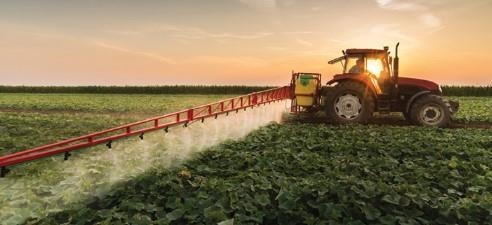
- Carefully read and follow the specific recommendations provided on the pesticide label, in nozzle manufacturer's catalogs, and sprayer operator’s manuals.
- Calibrate the sprayer to ensure the amount recommended on the label is applied.
- Check the sprayer set up to ensure the amount applied is distributed evenly across the spray swath.
- If more than one type of chemical is added to the sprayer tank, check product labels to ensure the mixing is done in the appropriate order.
- Conduct calibration of the sprayer, mixing, and loading of chemicals in areas without risk of ground/surface water pollution.
- Operate the nozzles at a pressure that allows them to produce the spray quality (droplet size) recommended on the product label.
- To achieve the best coverage on the target, select the appropriate types of nozzles for the product, and if applicable (not restricted by the label) keep the spray volume (carrier application rate) above 15 GPA for ground and 5 GPA for aerial applications.
- Pay special attention to the selection of nozzles when applying pesticides containing 2,4-D and Dicamba. Check the labels of these products for specific requirements for nozzles and operating pressure ranges.
- Follow recommendations to reduce spray drift to a minimum. The probability of spray drift is much greater with some nozzles than others, and when nozzles are operated at a much higher pressure than they are designed for which forces them to increase the number of drift-prone small droplets discharged.
- Slow down when spraying. Spray coverage is usually improved at slower speeds. The higher the travel speed, the greater likelihood of spray drift.
- For herbicide applications, flat-fan nozzles are better than cone nozzles which tend to produce a much smaller proportion of extremely small, drift-prone droplets.
- Good coverage of just the top of the canopy may be sufficient for adequate pest control with some products. However, both horizontal and vertical coverage of the plant may be necessary for other situations, such as disease and insects that may be hidden in lower parts of canopies.
- Air-assisted sprayers usually provide better coverage and droplet penetration into the canopy, than conventional sprayers when there is a full, dense canopy, such as soybeans sprayed in the late season.
- Be careful when using twin nozzle/pattern technology for the application of fungicides. Two nozzles or spray patterns angled (one forward, one backward), work better when the canopy is not dense and tall, or when the target is the upper part of the canopy, such as with a wheat head scab. Use single flow pattern nozzles under dense canopy conditions when penetration of droplets into the lower parts of the spray canopy is desired.
- Take advantage of technological advancements in spray technology, such as GPS, Pulse Width Modulation nozzles for selective and variable-rate spraying, and auto-guidance systems.
- Be safe. Wear protective clothing, goggles and rubber gloves, and respirators if required on the label, when calibrating the sprayer, doing the actual spraying, and cleaning the equipment.
Of course, there are equally important topics I did not mention here, including general inspection of the sprayer, importance of proper product agitation in the sprayer tank, adequate size hoses and fittings, determining sprayer setup for acceptable application rate, selecting proper boom height based on nozzle angle and spray overlap, cleanliness, and pH of water used to mix the products in the tank, proper cleaning of the sprayer tank, spray additives that can enhance product performance, and handling pesticide waste and empty containers. I will cover some of these topics in more detail in my future articles throughout the summer. However, as we get into the busy spraying season, I highly recommend you check two OSU extension publications for detailed discussions on the topics I covered and not covered in this article:
Wishing you a happy and safe spraying season!
Source : osu.edu